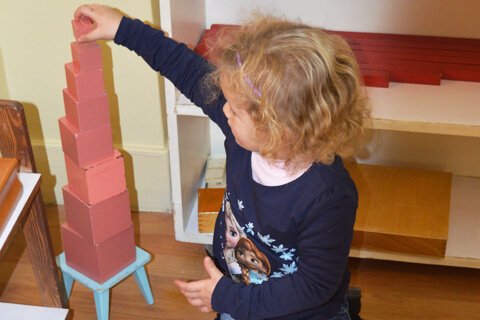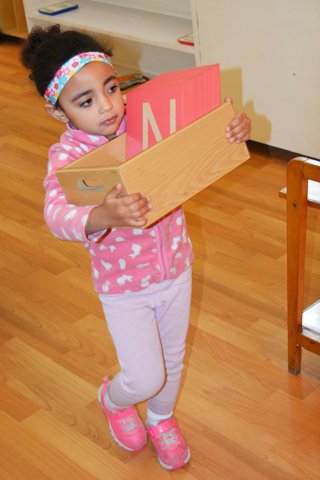Why Montessori?
As a parent, you should consider the Montessori program because of the many benefits it can offer your child today, while preparing them for tomorrow’s challenges and experiences. The Montessori environment:
Fosters independence and growth:
The Montessori classroom was designed to encourage children to get on with activities that capture their attention, in addition to different daily activities that the children carry out on their own at their own pace. This nurtures a sense of independence in the children, which, when fostered at a young age, can lead to promising character attributes in the future.
2. Enables children to learn at their own pace:
The Montessori approach believes that each child is unique in their own way, naturally following their own pace, depending on their interests and abilities. Each child is supported on their individual developmental path and allowed the time they need to master whatever they are learning at any given time.
3. Instills concentration and self-discipline:
The teachers lay ground rules in place without compromising the children’s freedom of choice in the classroom. These rules ensure that the children stay on track and not wander off course, naturally fostering self-discipline while emphasizing concentration, motivation, and self-control.
4. Introduces and familiarizes children with the concept of order:
Since all learning materials inside the Montessori classroom are within the children’s reach, it is mandatory for them to return whatever they use back to its designated place when they are done, establishing a sense of order while reinforcing discipline. It also upholds a clean and neat environment with space for the children’s imagination and creativity to flow.
5. Builds on key developmental stages:
The Montessori philosophy focuses on key developmental milestones in a child’s life, whether mental, physical, social or emotional. No matter where your child is at, the Montessori approach provides the necessary support, environment, and encouragement that enable a child to successfully progress through each stage.
6. Motivates fruitful supportive interaction:
Since the teacher does not ‘instruct’ the classroom, there is space for students to self-direct themselves to the activities they want to carry out. This freedom gives them time to cooperatively explore their classroom together, and to build a sense of respect for one another. By encouraging this, they form an early sense of community.
7. Nurtures children’s creativity:
Giving children the freedom to pick and choose what they want to learn is central in initiating the creative process. When the child knows there is no limit or time constraint to what they must pick, the need to produce an end product under pressure is gone, and a natural trail of creativity takes place.
8. Supports proactive and energetic learning:
The heart of the Montessori method focuses on character growth during a child’s early years. It emphasizes the concrete way of learning as opposed to the abstract. This concrete learning is implemented through the activities students work on in culture, language, math, and practical life lessons.
The Montessori Classroom
Environment & Design:
The Montessori classrooms’ environment is inviting and thoughtfully set up to reflect the Montessori philosophy. The colors of the classroom disseminate a sense of peacefulness and are mostly lit up by natural light. The walls are filled with pictures of nature, art, and culture aimed at enhancing the children’s sensory and intellectual experiences. The classrooms are set up in an open space layout to create a more comfortable and inviting atmosphere where the children can choose to work on tables or mats on the floor.
This prepared environment is the cornerstone of the Montessori method, inviting exploration and leading the child naturally from the concrete to the abstract. Different activities and experiences within movement allow the child to arrive at the exploration of language, math and other academic aspects smoothly, springing from the child’s own desire and interest.
Learning Materials:
The Montessori way has its own set of learning and educational activities that are specially designed using natural materials, and are quite appealing for children to touch and explore. Everything in a Montessori classroom is designed and scaled to best fit each individual child. The learning materials are placed on accessible shelves, allowing the children to move around and get what they need freely without limitations or a constant need for assistance. Each item introduces a distinct idea and teaches a certain skill, helping the child in his or her learning process.
Teachers' Role:
In Montessori education, teachers act more as classroom directors, becoming the link between the child and their environment. They do not try to control the classroom dynamics; they mainly focus on observing the children and helping them in their work by answering their questions, guiding them through new challenges, and overseeing their learning progress. They respect every child’s individuality and take every opportunity to respond to each child’s specific needs and interests as they bloom.
Multi-age classroom:
A typical Montessori classroom includes students from different age groups coexisting and working together. Older students enjoy helping younger ones with their activities, and younger students learn a lot by watching their older counterparts find their way around the classroom. They all work and grow together, building a sense of harmony in their integrated environment. The multi-age classroom organically establishes that respect, cooperation, trust, independence, self-reliance, and peace are the real motivators.









